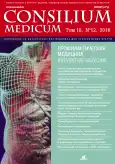Carbon dioxide exchange violation: features of the pathogenesis and diagnosis
- Authors: Shtabnitskiy V.A1,2
-
Affiliations:
- N.I.Pirogov Russian National Research Medical University of the Ministry of Health of the Russian Federation
- Research Institute of Pulmonology of FMBA of Russia
- Issue: Vol 18, No 12 (2016)
- Pages: 88-91
- Section: Articles
- URL: https://journals.rcsi.science/2075-1753/article/view/94622
- ID: 94622
Cite item
Full Text
Abstract
Full Text
##article.viewOnOriginalSite##About the authors
V. A Shtabnitskiy
N.I.Pirogov Russian National Research Medical University of the Ministry of Health of the Russian Federation; Research Institute of Pulmonology of FMBA of Russia
Email: Shtabnitskiy@gmail.com
канд. мед. наук, ассистент каф. госпитальной терапии педиатрического фак-та ФГБОУ ВО РНИМУ им. Н.И.Пирогова, науч. сотр. ФГБУ НИИ пульмонологии 117997, Russian Federation, Moscow, ul. Ostrovitianova, d. 1; 105077, Russian Federation, Moscow, ul. 11-ia Parkovaia, d. 32
References
- Энгельс Ф. Диалектика природы. М., 1975.
- Зильбер А.П. Дыхательная недостаточность. М.: Медицина, 1989.
- Шмидт Р., Тевс Г. Физиология человека. М.: Мир, 1996.
- Simonneau G, Robbins I.M et al. Updated clinical classification of pulmonary hypertension. J Am Coll Cardiol 2009; 54: S43-54.
- Conkin J. Equivalent Air Altitude and the Alveolar Gas Equation. Aerosp Med Hum Perform. 2016; 87 (1): 61-4. doi: 10.3357/AMHP.4421.2016.
- Beck K.C, Johnson B.D, Olson T.P, Wilson T.A. Ventilation - perfusion distributionin normal subjects. J Appl Physiol (1985) 2012; 113 (6): 872-7.
- Rafferty G.F, Lou Harris M, Polkey M.I et al. Effect ofhypercapnia on maximal voluntary ventilation and diaphragm fatigue in normalhumans. Am J Respir Crit Care Med 1999;160 (5 Pt. 1): 1567-71.
- Romer L.M, Polkey M.I. Exercise - induced respiratory muscle fatigue: implicationsfor performance. J Appl Physiol (1985) 2008; 104 (3): 879-88.
- Burton M.D, Kazemi H. Neurotransmitters in central respiratory control. Respir Physiol 2000; 122 (2-3): 111-21.
- Poon C.S, Tin C, Song G. Submissive hypercapnia: Why COPD patients are moreprone to CO2 retention than heart failure patients. Respir Physiol Neurobiol 2015; 216: 86-93.
- Bauman K.A, Kurili A, Schmidt S.L et al. Home - based overnight transcutaneous capnography/pulse oximetry for diagnosingnocturnal hypoventilation associated with neuromuscular disorders. Arch Phys Med Rehabil 2013; 94 (1): 46-52.
- Rasera C.C, Gewehr P.M, Domingues A.M. PET(CO2) measurement and featureextraction of capnogram signals for extubation outcomes from mechanicalventilation. Physiol Meas 2015; 36 (2): 231-42.
- Paschoal I.A, Villalba Wde O, Pereira M.C. Chronic respiratory failure inpatients with neuromuscular diseases: diagnosis and treatment. J Bras Pneumol 2007; 33 (1): 81-92.
- Iscoe S, Fisher J.A. Hyperoxia - induced hypocapnia: an underappreciated risk. Chest 2005; 128 (1): 430-3.
- Al Dabal L, Ba Hammam A.S. Cheyne - stokes respiration in patients with heartfailure. Lung 2010; 188 (1): 5-14.
- Sikter A, Frecska E, Braun I.M et al. The role ofhyperventilation: hypocapnia in the pathomechanism of panic disorder. Rev Bras Psiquiatr 2007; 29 (4): 375-9.
Supplementary files






